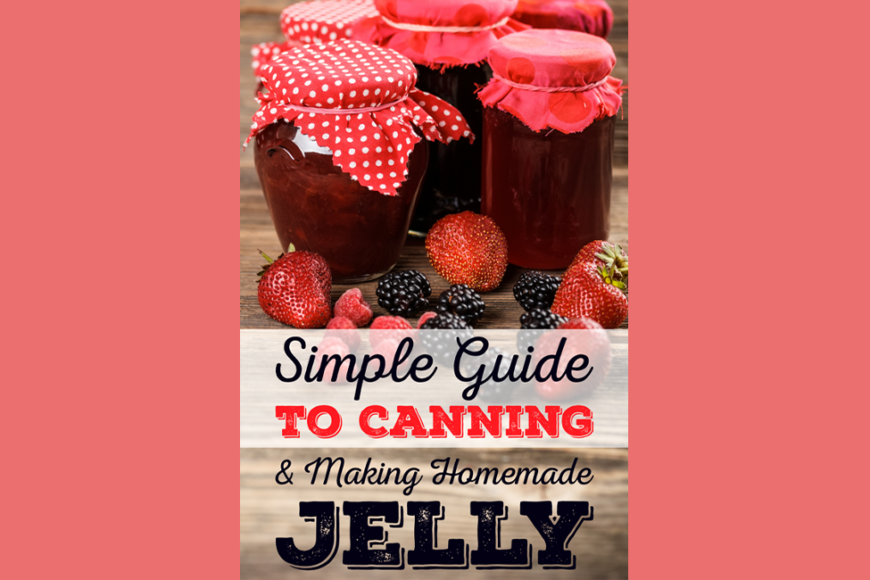
Simple Guide to Canning – Part 3: Step-by-Step Canning Directions
The following is a guest post by Raising A Family On A Budget.
Now that you know the basics of what you need to have on hand to make jam, let’s make a batch!
Step 1 – Before You Begin
Prepare boiling water canner by filling half-full with hot water. Keep water simmering while covered.
Heat jars and lids in hot, not boiling, water until ready to use. Keeping the jars hot helps prevent them from breaking when hot jam or jelly is added. To prevent seal failure, do not boil lids. Leave rings at room temperature for easy handling.
Step 2 – Prepare Your Fruit
No matter what type of fruit you are using, your ratios are the same.
1 1/3 cups of prepared fruit to 1 ½ Tbsp of pectin and 1 2/3 cups of sugar
To prepare strawberries, hull and crush one layer at a time with a potato masher. For peaches or pears, peel, pit, and finely chop. For raspberries, blueberries, or blackberries crush one layer at a time using a potato masher. For cherries, remove stems and pits, then finely chop.
To save time and energy, on large batches of fruit, I use my food processor to pulse chop it to the desired size. This goes for berries, as well as peaches.
For our recipe today we will be using strawberries.
Step 3 – Measure Out All Ingredients
|
Small Batch 2 half pint jars |
Standard Batch |
Large Batch |
|
| Cups of prepared fruit | 1 1/3 cups | 5 1/3 cups | 14 2/3 cups |
| Pectin | 1 ½ Tbsp | 6 Tbsp | 1 – 4.7 oz jar of pectin |
| Granulated sugar | 1 2/3 cups | 6 2/3 cups | 18 1/3 cups |
For blueberry, peach, and sweet cherry jams you will need to add lemon juice as well. Please follow the directions on your pectin to know how much to use.
Step 4 – Start Jamming
Combine the prepared fruit, lemon juice if required, and pectin in a large saucepan (6 – 8 qt for a standard batch of jam). Bring mixture to a full rolling boil that cannot be stirred down, over high heat, while stirring constantly.
Add entire measure of sugar, stirring to dissolve. Once all of the sugar has been incorporated, return to a full rolling boil. Boil hard for one minute, stirring constantly.
Remove from heat. Skim foam if necessary.
Step 5 – Filling and Sealing Your Jars
Remove jars from hot water, and place on a towel to prevent thermal shock and breakage.
Ladle hot jam into hot jars one at a time leaving ¼ headspace. Clean rim and threads of jars using a clean, damp cloth to remove any residue.
Center hot lids on jars, allowing sealing compound to come in contact with the jar rim. Apply bands and adjust until fit is finger tight.
Place filled jars in the water bath canner. Be sure water covers tops of jars by 1-2 inches. Add more hot water if necessary. Place lid on the canner, and bring water to a gentle, steady boil.
Process jars for 10 minutes. After processing is complete, turn off the heat and remove the lid to the canner. Let jars stand for 5 minutes more.
Remove jars from canner and place on a towel to cool. Ideally, jars will remain on the counter undisturbed for 12-24 hours. You will hear a popping noise as the jars form a good seal.
Once the jars have cooled, test the seals by pressing the center of the lid. If a lid flexes up and down, it did not seal properly and must go immediately go into the refrigerator or reprocess for the full amount of time using a new lid.
Sealed jars should be stored with the rings removed. Label and store in a cool, dry, dark place for up to 1 year.
While all recipes say that home canned goods are only good for 1 year, as long as the jars are maintaining a proper seal, then you can consume them for years to come. Before opening a jar, make sure the lid is still properly sealed. If it is no longer sealed – discard. Once open, look at the contents. If they look off, are bubbling, or fuzzy – discard. Take a quick sniff. If the product does not smell properly – discard. Personally, I have kept pickles and jellies for up to 3 years with much success.
Other posts in this series:
- Simple Guide to Canning and Making Homemade Jelly – Part 1: Introduction to Canning
- Simple Guide to Canning and Making Homemade Jelly – Part 2: Terminology and Supplies
- Simple Guide to Canning and Making Homemade Jelly – Part 4: Fruit and Pectin
Stephanie Huston is the mom behind Raising A Family On A Budget. Her main focus is saving families money through couponing and shopping sales for the items we need and would buy anyway. In addition, there are often ideas shared for other frugal aspects of our lives (cooking, dining out, DIY, vacation, etc).








4 Comments
Dawn
is the water bath canner just a pot of boiling water?
SHEILA ELLISON
THIS IS A GREAT THING U POSTING THIS BECAUSE ALOT OF PEOPLE DONT KNOW THIS,THANKS
elizabeth reisner
Just a quick tip: instead of giving it a processing bath at the end, just turn them all upside down for 15 minutes, and they are done! I tried it myself after a friend gave me the idea. Her mom and her have been processing jars that way for years, and never have a problem, and neither did I!
Stephanie
While that will give you a proper seal, it does not guarantee that all of the bacteria will be killed. You and your friend have been lucky. The only safe way to can is to put them in a water bath canner and process the jars.